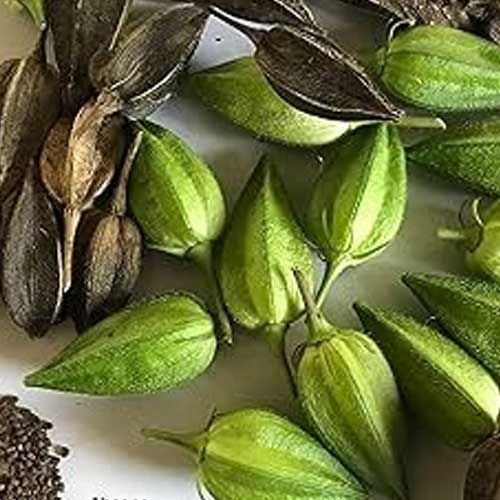Total Number of seeds: 25
Kasturi Bhindi Kasturi Ladies Finger Okra Seeds
Kasturi Bhindi Kasturi Ladies Finger Okra Seeds produce a rare, fragrant tropical shrub, also known as Abelmoschus moschatus. This versatile plant, native to India, is highly valued for its musky-scented seeds, beautiful flowers, and edible leaves. With its multiple uses in cooking, Ayurveda, and ornamental gardening, this plant is a must-have for your garden.
About This Item
- Variety Name: Kasturi Bhindi (Abelmoschus moschatus)
- Type of Seeds: Open-pollinated
- Germination Time: 7-10 days
- Hours of Sunlight: 6-8 hours of full sunlight daily
- Where to Grow: Suitable for garden beds and large pots
- Growing Season: Spring and summer are ideal
- Seed Sowing Depth: 1-1.5 cm deep
- Ideal Climate: Warm and tropical climates
- Plant Height: Grows up to 50-180 cm tall
- Plant Characteristics:
- Flowers: Large, yellow, hibiscus-like blooms
- Leaves: Hairy, with 3-5 lobes and a cordate base
- Stems: Reddish hairs on the stems
- Seeds: Dark, musky-scented, subreniform in shape
- Fertilizer Requirement: Organic compost or balanced fertilizer
- Life Span: Perennial in warm climates
- Ideal Growing Temperature: 20-35°C
- Harvesting Time: 50-70 days after sowing
- Maintenance Required: Minimal; regular watering and occasional fertilizing
- Watering Frequency: Regular watering to keep soil moist but avoid waterlogging
- Ideal Grow Bag Size: 12-15 inches (if grown in pots)


What Size Grow Bag is Best for Kasturi Bhindi Kasturi Ladies Finger Okra Seeds
Growing Season in India
Kasturi Bhindi thrives in warm, tropical climates, making it ideal for spring and summer sowing. The plant requires plenty of sunlight and well-drained soil for optimal growth.
How to Grow in Pots
To grow Kasturi Bhindi in pots:
- Choose a pot that is 12-15 inches deep with proper drainage.
- Fill the pot with nutrient-rich, well-drained soil mixed with compost.
- Sow seeds 1-1.5 cm deep and water gently.
- Place the pot in a sunny location with 6-8 hours of sunlight daily.
- Thin seedlings as they grow to provide enough space for healthy development.
Seeds Sowing Method
- Preparation: Use well-drained, compost-rich soil.
- Sowing: Sow seeds 1-1.5 cm deep directly in rows or pots.
- Watering: Water gently to keep the soil consistently moist.
- Germination: Seeds will sprout within 7-10 days.
- Transplanting: Space plants 2-3 feet apart for optimal growth.
Plant Care Tips
- Sunlight: Ensure plants receive 6-8 hours of sunlight daily.
- Soil: Use nutrient-rich, well-drained soil for optimal growth.
- Fertilization: Apply compost or balanced fertilizer every 2-3 weeks.
- Pest Control: Use neem oil or organic sprays to manage pests like aphids or whiteflies.
- Harvesting: Begin harvesting leaves and shoots as the plant matures, and collect seeds when fully ripe.
How to Fertilize Vegetable Plants Effectively
1. Apply Nutrient-Rich Fertilizers
When your plants begin flowering, use nutrient-rich fertilizers like Organic Bone Meal Powder or Vermicompost. This helps in boosting the bloom and enhances overall yield.
2. Use Organic Fertilizers
Feed your plants with organic fertilizers such as Cow Dung Manure or Neem Cake. Organic options promote healthy soil life.
3. Regular Feeding
Apply fertilizers every 20-25 days to ensure plants receive a steady supply of nutrients. Choose from various options like Cocopeat Compost for moisture retention
Special Features
- Fragrant Seeds: Musky-scented seeds are perfect as a natural flavor enhancer.
- Versatile Uses: Leaves and shoots are edible, and seeds are used in cooking and Ayurveda.
- Ornamental Value: Large yellow flowers and reddish stems add beauty to gardens.
- Multiple Benefits: Offers culinary, medicinal, and aesthetic advantages.
Benefits/Uses
- Culinary Uses:
- Seeds enhance the flavor of dishes.
- Leaves and young shoots are cooked as vegetables.
- Medicinal Uses: Widely used in Ayurveda for its health benefits.
- Ornamental: Attractive flowers and foliage make it perfect for home gardens.
Precautions While Growing
- Avoid overwatering to prevent root rot.
- Use organic manure to enhance growth and fruit quality.
- Protect plants from strong winds due to their tall growth.
FAQs
Q1: How long does it take for Kasturi Bhindi seeds to germinate?
A1: Seeds typically germinate within 7-10 days.
Q2: Can Kasturi Bhindi be grown in pots?
A2: Yes, this variety grows well in 12-15 inch pots with proper care.
Q3: How often should I water the plants?
A3: Water regularly to keep the soil moist, especially during the growing stage.
Q4: What are the main uses of Kasturi Bhindi?
A4: The seeds are used as a flavor enhancer, leaves and shoots are edible, and the plant has applications in Ayurveda.


Girish Kumar
Soft and tender pods were perfect for daily cooking.
Swati R
Plants compact the aur yield continuous mila.
Anu
Good variety for home gardeners looking for steady yield.
Mahesh D
taste bahut accha tha aur pods soft aaye.
Kavita S
Beej quality acchi thi, sprouting uniform mila.
Anita Pillai
Seedlings adapted well after transplanting.
Usha L
Sprouting was consistent and seedlings established quickly.
Teena
Tender pods aa rahe the, cooking me bahut acchi lagi.
Pavan
The plants maintained upright growth and strong stems.
Rohan Menon
Results ka wait hai, flowering lagatar aa rahi hai.